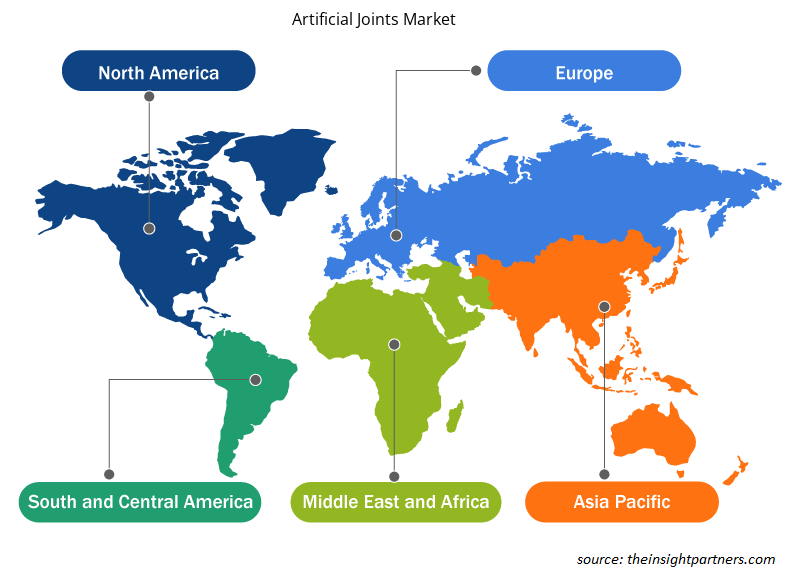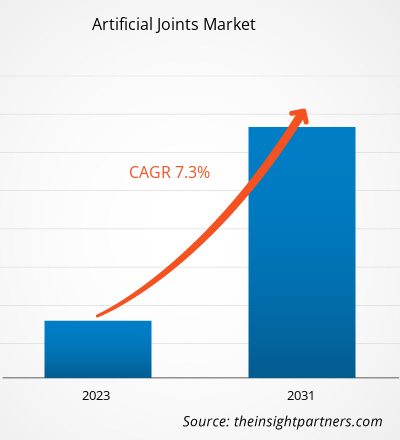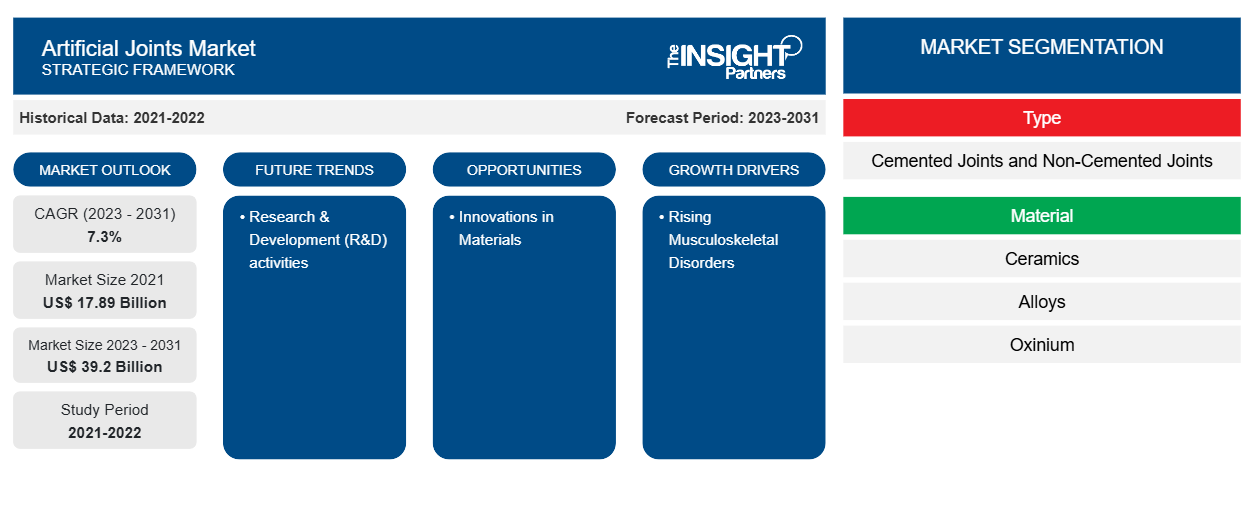El mercado de articulaciones artificiales se valoró en 17.890 millones de dólares estadounidenses en 2021 y se espera que alcance los 39.200 millones de dólares estadounidenses en 2031. Se espera que el mercado registre una CAGR del 7,3 % entre 2023 y 2031. Es probable que las actividades de investigación y desarrollo (I+D) sigan siendo tendencias clave en el mercado de articulaciones artificiales.
Análisis de mercado de articulaciones artificiales
Trastornos musculoesqueléticos en aumento
Los reemplazos articulares se han convertido en un factor intrínseco para el mantenimiento y la restauración para tratar una amplia gama de problemas musculoesqueléticos entre los trastornos musculoesqueléticos. Por ejemplo, en 2019, en Inglaterra, se realizaron más de 200.000 reemplazos de cadera y rodilla, con 189 reemplazos de cadera y 130 reemplazos de rodilla. Por lo tanto, con el aumento de los trastornos musculoesqueléticos, existe una demanda acelerada de articulaciones artificiales. Las articulaciones artificiales modernas son productos de alta tecnología fabricados con materiales especializados utilizando equipos tecnológicos únicos. Estos diseños están justificados y diseñados en función de métodos de análisis del sistema, el estado fisiológico de los pacientes y la eliminación de las complicaciones. Por lo tanto, el desarrollo de articulaciones artificiales modernas con opción de cirugía no invasiva, menos dolorosas para los pacientes, son los factores más influyentes responsables del crecimiento del mercado de articulaciones artificiales durante 2021-2031.
Descripción general del mercado de articulaciones artificiales
La tecnología, la innovación y las soluciones tecnológicas inteligentes siguen influyendo significativamente en las articulaciones artificiales. El aumento de los trastornos musculoesqueléticos y las tecnologías inteligentes en las articulaciones artificiales son los factores más influyentes responsables del crecimiento del mercado de las articulaciones artificiales. Las actividades de investigación y desarrollo (I+D) son una tendencia clave para el crecimiento del mercado de las articulaciones artificiales. Las innovaciones en materiales brindarán una oportunidad de mercado lucrativa.
Personalice este informe según sus necesidades
Obtendrá personalización en cualquier informe, sin cargo, incluidas partes de este informe o análisis a nivel de país, paquete de datos de Excel, así como también grandes ofertas y descuentos para empresas emergentes y universidades.
- Obtenga las principales tendencias clave del mercado de este informe.Esta muestra GRATUITA incluirá análisis de datos, desde tendencias del mercado hasta estimaciones y pronósticos.
Articulaciones artificiales: factores impulsores y oportunidades del mercado
Tecnologías inteligentes en articulaciones artificiales favorecen el mercado
Los fabricantes quieren diseñar implantes ortopédicos inteligentes que controlen la evolución de los pacientes. Webster es uno de esos fabricantes que está en proceso de desarrollo de implantes ortopédicos inteligentes que controlan la evolución de los pacientes y luego transmiten la información a los profesionales sanitarios a través de la radio y un dispositivo portátil. Si se produce una infección, los implantes no sólo podrían alertar a los médicos, sino que también pueden liberar un fármaco. Tradicionalmente, el titanio, un material resistente y ligero, es una opción de material para los implantes artificiales. Sin embargo, Webster está utilizando un material diferente al titanio con una superficie oxidada recubierta de nanotubos de carbono que funcionan como electrodo. Al aplicar un voltaje y medir la conductividad de la superficie del implante, los médicos podrían utilizar los nanotubos para detectar una de las tres cosas que pueden sucederle a un implante. Por lo tanto, las articulaciones artificiales inteligentes ocuparán un mercado considerable en los próximos años e incluso los principales fabricantes como Zimmer Biomet desarrollarán dispositivos que superarán los métodos tradicionales de implantes de articulaciones artificiales.
Innovaciones en materiales para el mercado de articulaciones artificiales: una oportunidad
Con la innovación en las técnicas quirúrgicas , procedimientos como reemplazos de cadera y operaciones de rodilla se han convertido en una práctica común. Además, la innovación en materiales para articulaciones artificiales proporcionará oportunidades de mercado lucrativas para los fabricantes a largo plazo. Por ejemplo, el desarrollo de un tipo patentado de nailon se puede utilizar como revestimiento adicional sobre la superficie plástica de una articulación de reemplazo. Esta superficie cubre la parte esférica de una articulación esférica, generalmente compuesta de un material de "polietileno de peso molecular ultraalto (UHMWPE)". Además, todavía se están realizando experimentos utilizando el revestimiento de nailon para fusionarlo con el UHMWPE para crear un nuevo material con características interesantes. Por lo tanto, la innovación en materiales para articulaciones artificiales proporcionará oportunidades de mercado lucrativas que representarán una participación de mercado considerable en los próximos años.
Articulaciones artificiales
Análisis de segmentación de informes de mercado
Los segmentos clave que contribuyeron a la derivación del análisis del mercado de articulaciones artificiales son la candidatura y los servicios.
- Según el tipo, el mercado de articulaciones artificiales se divide en articulaciones cementadas y articulaciones no cementadas. Las articulaciones cementadas podrían tener una mayor participación de mercado en 2023.
- Según el material, el mercado de articulaciones artificiales se segmenta en cerámica, aleaciones, oxinio y otros. La cerámica podría tener una mayor participación de mercado en 2023.
- Según la aplicación, el mercado de articulaciones artificiales se segmenta en articulaciones artificiales de rodilla, articulaciones artificiales de cadera, articulaciones artificiales de hombro y otras. Las articulaciones artificiales de rodilla podrían tener una mayor participación de mercado en 2023.
- Según el usuario final, el mercado de prótesis articulares se segmenta en hospitales, centros de atención ambulatoria y otros. Los hospitales podrían tener una mayor participación de mercado en 2023.
Análisis de la cuota de mercado de las articulaciones artificiales por geografía
El alcance geográfico del informe de mercado de articulaciones artificiales se divide principalmente en cinco regiones: América del Norte, Asia Pacífico, Europa, Medio Oriente y África, y América del Sur / América del Sur y Central.
América del Norte ha dominado el mercado de articulaciones artificiales. En América del Norte, Estados Unidos representa una participación considerable en el mercado de articulaciones artificiales. La presencia de los principales fabricantes médicos en Estados Unidos y el aumento de las actividades de I+D en términos de materiales son los factores más influyentes responsables del crecimiento del mercado. Se prevé que Asia Pacífico crezca con la CAGR más alta en los próximos años.
Articulaciones artificiales
Alcance del informe de mercado
Perspectivas regionales del mercado de articulaciones artificiales
Los analistas de Insight Partners explicaron en detalle las tendencias y los factores regionales que influyen en el mercado de articulaciones artificiales durante el período de pronóstico. Esta sección también analiza los segmentos y la geografía del mercado de articulaciones artificiales en América del Norte, Europa, Asia Pacífico, Oriente Medio y África, y América del Sur y Central.

- Obtenga datos regionales específicos para el mercado de articulaciones artificiales
Alcance del informe de mercado sobre articulaciones artificiales
| Atributo del informe | Detalles |
|---|---|
| Tamaño del mercado en 2021 | US$ 17.89 mil millones |
| Tamaño del mercado en 2031 | US$ 39,2 mil millones |
| CAGR global (2023 - 2031) | 7,3% |
| Datos históricos | 2021-2022 |
| Período de pronóstico | 2023-2031 |
| Segmentos cubiertos | Por tipo
|
| Regiones y países cubiertos | América del norte
|
| Líderes del mercado y perfiles de empresas clave |
|
Densidad de actores del mercado: comprensión de su impacto en la dinámica empresarial
El mercado de articulaciones artificiales está creciendo rápidamente, impulsado por la creciente demanda de los usuarios finales debido a factores como la evolución de las preferencias de los consumidores, los avances tecnológicos y una mayor conciencia de los beneficios del producto. A medida que aumenta la demanda, las empresas amplían sus ofertas, innovan para satisfacer las necesidades de los consumidores y aprovechan las tendencias emergentes, lo que impulsa aún más el crecimiento del mercado.
La densidad de actores del mercado se refiere a la distribución de las empresas o firmas que operan dentro de un mercado o industria en particular. Indica cuántos competidores (actores del mercado) están presentes en un espacio de mercado determinado en relación con su tamaño o valor total de mercado.
Las principales empresas que operan en el mercado de articulaciones artificiales son:
- Zimmer Biomet,
- Smith y sobrino,
- Estridente,
- Medtronic,
- Servicios Johnson & Johnson, Inc.,
- Exactech, Inc.,
Descargo de responsabilidad : Las empresas enumeradas anteriormente no están clasificadas en ningún orden particular.

- Obtenga una descripción general de los principales actores clave del mercado de articulaciones artificiales
Articulaciones artificialesNoticias del mercado y novedades recientes
El mercado de articulaciones artificiales se evalúa mediante la recopilación de datos cualitativos y cuantitativos a partir de una investigación primaria y secundaria, que incluye publicaciones corporativas importantes, datos de asociaciones y bases de datos. A continuación, se incluye una lista de los avances en el mercado de articulaciones artificiales y las estrategias:
- En febrero de 2020, RSIP Vision anunció la introducción de una tecnología de visión basada en computadora para visualizar con mayor precisión el hueso antes de los procedimientos de reemplazo de rodilla y cadera para reducir el error humano.
Cobertura y resultados del informe de mercado sobre articulaciones artificiales
El informe “Tamaño y pronóstico del mercado de articulaciones artificiales (2021-2031)” proporciona un análisis detallado del mercado que cubre las siguientes áreas:
- Tamaño del mercado y pronóstico a nivel global, regional y nacional para todos los segmentos clave del mercado cubiertos bajo el alcance
- Dinámica del mercado, como impulsores, restricciones y oportunidades clave
- Principales tendencias futuras
- Análisis detallado de las cinco fuerzas de Porter y PEST y FODA
- Análisis del mercado global y regional que cubre las tendencias clave del mercado, los principales actores, las regulaciones y los desarrollos recientes del mercado.
- Análisis del panorama de la industria y de la competencia que abarca la concentración del mercado, el análisis de mapas de calor, los actores destacados y los desarrollos recientes
- Perfiles detallados de empresas
- Análisis histórico (2 años), año base, pronóstico (7 años) con CAGR
- Análisis PEST y FODA
- Tamaño del mercado, valor/volumen: global, regional y nacional
- Industria y panorama competitivo
- Conjunto de datos de Excel
Informes recientes
Testimonios
Razón para comprar
- Toma de decisiones informada
- Comprensión de la dinámica del mercado
- Análisis competitivo
- Información sobre clientes
- Pronósticos del mercado
- Mitigación de riesgos
- Planificación estratégica
- Justificación de la inversión
- Identificación de mercados emergentes
- Mejora de las estrategias de marketing
- Impulso de la eficiencia operativa
- Alineación con las tendencias regulatorias





















 Obtenga una muestra gratuita para - Mercado de articulaciones artificiales
Obtenga una muestra gratuita para - Mercado de articulaciones artificiales